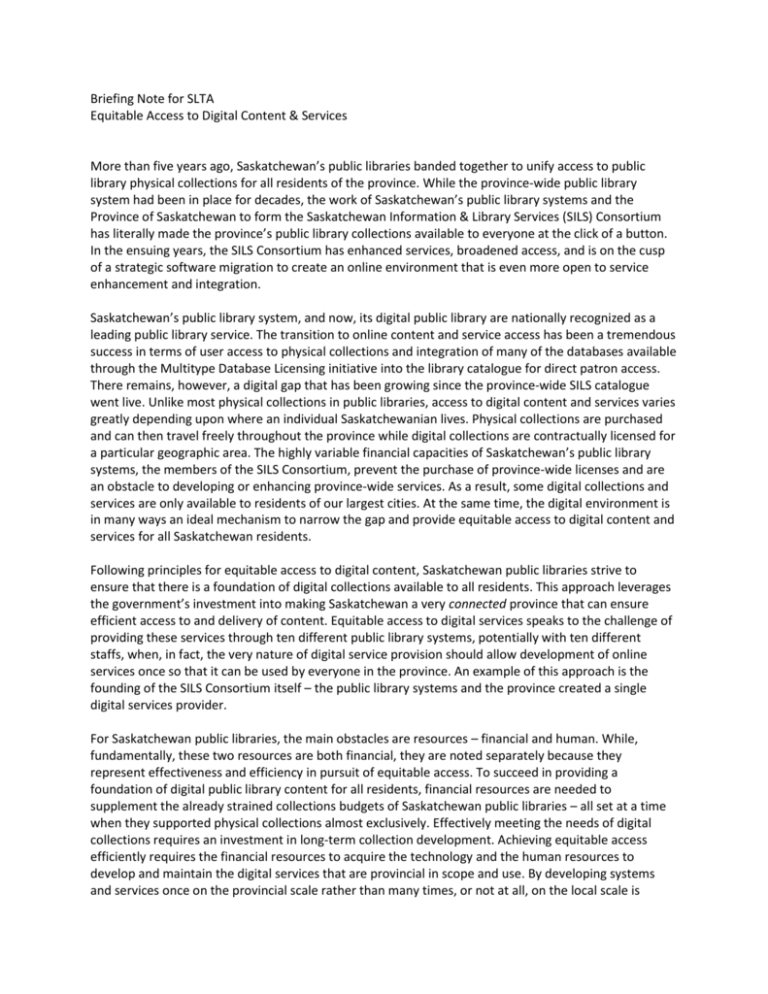Equitable Digital Access, Briefing Note, June 10, 2015
advertisement

Briefing Note for SLTA Equitable Access to Digital Content & Services More than five years ago, Saskatchewan’s public libraries banded together to unify access to public library physical collections for all residents of the province. While the province-wide public library system had been in place for decades, the work of Saskatchewan’s public library systems and the Province of Saskatchewan to form the Saskatchewan Information & Library Services (SILS) Consortium has literally made the province’s public library collections available to everyone at the click of a button. In the ensuing years, the SILS Consortium has enhanced services, broadened access, and is on the cusp of a strategic software migration to create an online environment that is even more open to service enhancement and integration. Saskatchewan’s public library system, and now, its digital public library are nationally recognized as a leading public library service. The transition to online content and service access has been a tremendous success in terms of user access to physical collections and integration of many of the databases available through the Multitype Database Licensing initiative into the library catalogue for direct patron access. There remains, however, a digital gap that has been growing since the province-wide SILS catalogue went live. Unlike most physical collections in public libraries, access to digital content and services varies greatly depending upon where an individual Saskatchewanian lives. Physical collections are purchased and can then travel freely throughout the province while digital collections are contractually licensed for a particular geographic area. The highly variable financial capacities of Saskatchewan’s public library systems, the members of the SILS Consortium, prevent the purchase of province-wide licenses and are an obstacle to developing or enhancing province-wide services. As a result, some digital collections and services are only available to residents of our largest cities. At the same time, the digital environment is in many ways an ideal mechanism to narrow the gap and provide equitable access to digital content and services for all Saskatchewan residents. Following principles for equitable access to digital content, Saskatchewan public libraries strive to ensure that there is a foundation of digital collections available to all residents. This approach leverages the government’s investment into making Saskatchewan a very connected province that can ensure efficient access to and delivery of content. Equitable access to digital services speaks to the challenge of providing these services through ten different public library systems, potentially with ten different staffs, when, in fact, the very nature of digital service provision should allow development of online services once so that it can be used by everyone in the province. An example of this approach is the founding of the SILS Consortium itself – the public library systems and the province created a single digital services provider. For Saskatchewan public libraries, the main obstacles are resources – financial and human. While, fundamentally, these two resources are both financial, they are noted separately because they represent effectiveness and efficiency in pursuit of equitable access. To succeed in providing a foundation of digital public library content for all residents, financial resources are needed to supplement the already strained collections budgets of Saskatchewan public libraries – all set at a time when they supported physical collections almost exclusively. Effectively meeting the needs of digital collections requires an investment in long-term collection development. Achieving equitable access efficiently requires the financial resources to acquire the technology and the human resources to develop and maintain the digital services that are provincial in scope and use. By developing systems and services once on the provincial scale rather than many times, or not at all, on the local scale is consistent with the resource sharing principles embraced by Saskatchewan libraries, and embodied in their legislation. The SILS Consortium, working on behalf of all public libraries in the province, has created the service delivery hub through the single integrated library system. Public libraries are ready to use that hub to meet user needs, no matter where they are in the province, through: Apps and responsive design for mobile devices; Customer empowerment through online self-service; Personalized services that can adapt to user preferences; Integrated social media to connect communities; Partnerships that will add Saskatchewan content; and Collections of books, videos, audiobooks, and music for download or streaming. Equitable access to Digital Content and Services is a goal of Saskatchewan libraries. The challenge is to adequately fund the program to facilitate aggressive development of new services. If steps are not taken to deal with the issue of regional disparity, there is a real danger that unequal levels of service among Saskatchewan libraries will occur. Since one of the goals of SILS is to provide equal levels of service, we would respectfully request the Government of Saskatchewan work toward equalizing access to digital content and services.







